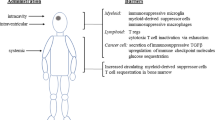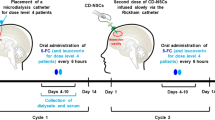Abstract
Since neural stem cells (NSCs) have the ability to migrate toward a tumor mass, genetically engineered NSCs were used for the treatment of gliomas. We first evaluated the “bystander effect” between NSCs transduced with the herpes simplex virus-thymidine kinase (HSVtk) gene (NSCtk) and C6 rat glioma cells under both in vitro and in vivo conditions. A potent bystander effect was observed in co-culture experiments of NSCtk and C6 cells. In the intracranial co-implantation experiments in athymic nude mice and Sprague–Dawley rats, the animals co-implanted with NSCtk and C6 cells and treated with ganciclovir (GCV) showed no intracranial tumors and survived more than 100 days, while those treated with physiological saline (PS) died of tumor progression. We next injected NSCtk cells into the pre-existing C6 tumor in rats and treated them with GCV or PS. The tumor volume was serially measured by magnetic resonance imaging. The tumor disappeared in six out of nine rats in the NSCtk/GCV group, while all the rats treated with PS died of tumor progression by day 21. The results indicate the feasibility of a novel gene therapy strategy for gliomas through a bystander effect generated by intratumoral injection of NSCtk cells and systemic GCV administration.
This is a preview of subscription content, access via your institution
Access options
Subscribe to this journal
Receive 12 print issues and online access
$259.00 per year
only $21.58 per issue
Buy this article
- Purchase on Springer Link
- Instant access to full article PDF
Prices may be subject to local taxes which are calculated during checkout






Similar content being viewed by others
References
Surawicz TS, Davis F, Freels S, Laws ER, Menck HR . Brain tumor survival: results from the National Cancer Data Base. Neurooncology. 1998;40:151–160.
Ram Z, Culver KW, Oshiro EM, et al. Therapy of malignant brain tumors by intratumoral implantation of retroviral vector-producing cells. Nat Med. 1997;3:1354–1361.
Culver KW, Ram Z, Wallbridge S, Ishii H, Oldfield EH, Blaese RM . In vivo gene transfer with retroviral vector-producer cells for treatment of experimental brain tumors. Science. 1992;256:1550–1552.
Namba H, Tagawa M, Iwadate Y, Kimura M, Sueyoshi K, Sakiyama S . Bystander effect-mediated therapy of experimental brain tumor by genetically engineered tumor cells. Hum Gene Ther. 1998;9:5–11.
Namba H, Tagawa M, Miyagawa T, Iwadate Y, Sakiyama S . Treatment of rat experimental brain tumors by herpes simplex virus thymidine kinase gene-transduced allogeneic tumor cells and ganciclovir. Cancer Gene Ther. 2000;7:947–953.
Aboody KS, Brown A, Rainov NG, et al. Neural stem cells display extensive tropism for pathology in adult brain: evidence from intracranial gliomas. Proc Natl Acad Sci USA. 2000;97:12846–12851.
Temple S . The development of neural stem cells. Nature. 2001;414:112–117.
Wennersten A, Meier X, Holmin S, Wahlberg L, Mathiesen T . Proliferation, migration, and differentiation of human neural stem/progenitor cells after transplantation into a rat model of traumatic brain injury. J Neurosurg. 2004;100:88–96.
Namba H, Iwadate Y, Tagawa M, et al. Evaluation of the bystander effect in experimental brain tumors bearing herpes simplex virus-thymidine kinase gene by serial magnetic resonance imaging. Hum Gene Ther. 1996;7:1847–1852.
Mosmann T . Rapid colorimetric assay for cellular growth and survival: application to proliferation and cytotoxicity assays. J Immunol Methods. 1983;65:55–63.
Moolten FL . Tumor chemosensitivity conferred by inserted herpes thymidine kinase genes: paradigm for a prospective cancer control strategy. Cancer Res. 1986;46:5276–5281.
Moolten FL, Wells JM . Curability of tumors bearing herpes thymidine kinase genes transferred by retroviral vectors. J Natl Cancer Inst. 1990;82:297–300.
Rainov NG . A phase III clinical evaluation of herpes simplex virus type 1 thymidine kinase and ganciclovir gene therapy as an adjuvant to surgical resection and radiation in adults with previously untreated glioblastoma multiforme. Hum Gene Ther. 2000;11:2389–2401.
Namba H, Iwadate Y, Kawamura K, Sakiyama S, Tagawa M . Efficacy of the bystander effect in the herpes simplex virus thymidine kinase-mediated gene therapy is influenced by the expression of connexin43 in the target cells. Cancer Gene Ther. 2001;8:414–420.
Hamel W, Magnelli L, Chiarugi VP, Israel MA . Herpes simplex virus thymidine kinase/ganciclovir-mediated apoptotic death of bystander cells. Cancer Res. 1996;56:2697–2702.
Reynolds BA, Weiss S . Generation of neurons and astrocytes from isolated cells of the adult mammalian central nervous system. Science. 1992;255:1707–1710.
Benedetti S, Pirola B, Pollo B, et al. Gene therapy of experimental brain tumors using neural progenitor cells. Nat Med. 2000;6:447–450.
Ehtesham M, Kabos P, Kabosova A, Neuman T, Black KL, Yu JS . The use of interleukin 12-secreting neural stem cells for the treatment of intracranial glioma. Cancer Res. 2002;62:5657–5663.
Ehtesham M, Kabos P, Gutierrez M, et al. Induction of glioblastoma apoptosis using neural stem cell-mediated delivery of tumor necrosis factor-related apoptosis-inducing ligand. Cancer Res. 2002;62:7170–7174.
Barresi V, Belluardo N, Sipione S, Mudo G, Cattaneo E, Condorelli DF . Transplantation of prodrug-converting neural progenitor cells for brain tumor therapy. Cancer Gene Ther. 2003;10:396–402.
Lundberg C, Martinez-Serrano A, Cattaneo E, McKay RD, Bjorklund A . Survival, integration, and differentiation of neural stem cell lines after transplantation to the adult rat striatum. Exp Neurol. 1997;145:342–360.
Lee J, Elkahloun AG, Messina SA, et al. Cellular and genetic characterization of human adult bone marrow-derived neural stem-like cells: a potential antiglioma cellular vector. Cancer Res. 2003;63:8877–8889.
Nakamura K, Ito Y, Kawano Y, et al. Antitumor effect of genetically engineered mesenchymal stem cells in a rat glioma model. Gene Therapy. 2004;11:1155–1164.
Author information
Authors and Affiliations
Corresponding author
Rights and permissions
About this article
Cite this article
Li, S., Tokuyama, T., Yamamoto, J. et al. Bystander effect-mediated gene therapy of gliomas using genetically engineered neural stem cells. Cancer Gene Ther 12, 600–607 (2005). https://doi.org/10.1038/sj.cgt.7700826
Received:
Published:
Issue Date:
DOI: https://doi.org/10.1038/sj.cgt.7700826
Keywords
This article is cited by
-
Therapeutic effects against high-grade glioblastoma mediated by engineered induced neural stem cells combined with GD2-specific CAR-NK
Cellular Oncology (2023)
-
Recent progress in the research of suicide gene therapy for malignant glioma
Neurosurgical Review (2021)
-
Gene editing for immune cell therapies
Nature Biotechnology (2019)
-
Neural stem/progenitor cells react to non-glial cns neoplasms
SpringerPlus (2015)
-
Assessment of bystander killing-mediated therapy of malignant brain tumors using a multimodal imaging approach
Stem Cell Research & Therapy (2015)



